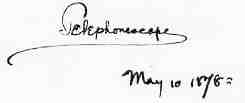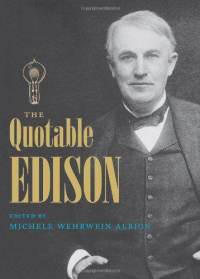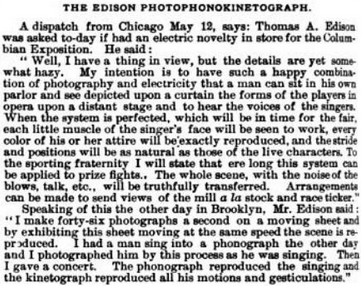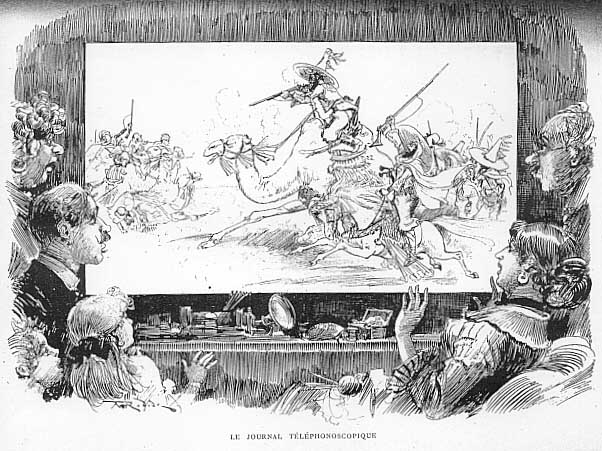What It Was Was Television
Did Thomas Edison predict television? According to some histories, the answer is yes, and the evidence is the image below, published on December 9, 1878 and captioned “Edison’s Telephonoscope (Transmits Light As Well As Sound).”
The award-winning historian Erik Barnouw referred to it as a “startling prediction,” though he correctly attributed it to writer and artist George du Maurier, not to Edison himself. Perhaps the image below will help you decide whether du Maurier was trying to predict anything. Published in the same periodical as the image above, Punch’s Almanack for 1879, it depicts the use of another supposed Edison invention, Anti-Gravitation Under-Clothing.
 Punch was a humor publication, but neither that fact nor the anti-gravitation under-clothing has prevented some from insisting, based on the top image, that Edison predicted television.
Punch was a humor publication, but neither that fact nor the anti-gravitation under-clothing has prevented some from insisting, based on the top image, that Edison predicted television. In fact, Edison did invent a telephonoscope, and it was well-publicized in the middle of 1878!
In fact, Edison did invent a telephonoscope, and it was well-publicized in the middle of 1878!
Unfortunately, it had nothing whatsoever to do with any form of television or image transmission. At left above is the word “telephonoscope” written by Edison, himself, for a patent caveat filed on May 10, 1878. At right is Edison’s drawing of the device, essentially a large, dual-tripod-mounted, binaural, ear trumpet for amplifying sounds.
Although the word telephonoscope was later used by another writer and cartoonist, Albert Robida, to describe television (see above), it seems pretty clear that Edison had nothing to do with it. In fact, it seems Edison didn’t like television under any name.
 Last year, in a well-referenced book called The Quotable Edison, published by the University Press of Florida, editor Michele Wehrwein Albion wrote of the inventor, “Though he was in his eighties when television was pioneered, he felt threatened by the new technology, decades before it would be in everyday use.” The selected Edison quotations about television corroborate the statement.
Last year, in a well-referenced book called The Quotable Edison, published by the University Press of Florida, editor Michele Wehrwein Albion wrote of the inventor, “Though he was in his eighties when television was pioneered, he felt threatened by the new technology, decades before it would be in everyday use.” The selected Edison quotations about television corroborate the statement.
Here are two of them: “[Television is] possible, but of very little general value. It’s a stunt” (The New York Times, February 12, 1927). “Locomotives are pretty well developed, but you wouldn’t want to buy one and have it in your house, would you? Television is like that” (The New York Times, December 24, 1930).
So Edison didn’t invent, like, or predict television? Well, actually, no.
Another quote from the book is this one: “[A] man can sit in his own parlor and see depicted upon a curtain the forms of players in opera upon a distant stage, and to hear the voices of the singers.” It is taken from the May 20, 1891 issue of the periodical The Electrical Engineer. It’s listed as one of the book’s motion-picture quotes, and there’s no question that publication would have considered the characterization correct at the time.
 The periodical’s article is titled “The Edison Photophonokinetograph,” and it ends with Edison clearly describing a sound movie apparatus. But there’s a problem. The first part of the article is based on “a dispatch from Chicago May 12;” the last part, the part that’s unquestionably about a motion-picture apparatus, is from Brooklyn.
The periodical’s article is titled “The Edison Photophonokinetograph,” and it ends with Edison clearly describing a sound movie apparatus. But there’s a problem. The first part of the article is based on “a dispatch from Chicago May 12;” the last part, the part that’s unquestionably about a motion-picture apparatus, is from Brooklyn.
There are other peculiarities. Why use the word “distant” if referring to a movie system? And why (just before the Brooklyn section) reference stock and race tickers, which are live, not recorded?
 Fortunately, The Electrical Engineer is not the only source for that story of the Edison prediction. It appeared not only in all of the Chicago newspapers of the time but also in newspapers and other publications around the world.
Fortunately, The Electrical Engineer is not the only source for that story of the Edison prediction. It appeared not only in all of the Chicago newspapers of the time but also in newspapers and other publications around the world.
The earliest publication of that prediction (shown at left, from a clipping at Thomas Edison National Historic Park) — the same day Edison made his statement — is from The Chicago Evening Post, Tuesday, May 12, 1891. The article’s headline was “Edison’s in Chicago.”
The world’s most famous inventor had come to town to discuss electric power at the upcoming World’s Columbian Exposition, a World’s Fair intended to celebrate the 400th anniversary of Christopher Columbus’s first voyage of discovery. It was a big deal (see the Fair’s Electricity Building below), so he was swarmed with press.
As it turned out, Westinghouse underbid Edison and ended up providing the electric power and lighting that led (at least in part) to the fair’s being called “The White City.” But no one knew about that on May 12, 1891, so Edison was asked about what he’d show at the fair. He said he had so much to show that he wanted more than an acre of exhibit space. And what specific “novelty” might he show?
The answer to that question was reported differently in different publications. According to one, The Chicago Tribune, on May 13, it was “the kinetograph,” “a combination of photography and phonography.” That’s a good description of a sound movie, and, in an age when both phonographs and movie systems were hand cranked, there was no need for electricity. But, as in the report in The Electrical Engineer, most publications called it “a happy combination of photography and electricity” (emphasis added).
 At right is a portion of that first published report in The Chicago Evening Post. It indicates that the viewer will require “having electrical connection with the theatre” in order to see and hear what’s going on there. Movies do not require such a connection.
At right is a portion of that first published report in The Chicago Evening Post. It indicates that the viewer will require “having electrical connection with the theatre” in order to see and hear what’s going on there. Movies do not require such a connection.
The Wellington, New Zealand Evening Post noted the new invention’s similarity to the telephone (but including a visual element) and quoted Edison as saying that, if opera singer Adelina Patti “be singing somewhere, this invention will put her full length picture upon canvas so perfectly as to enable one to distinguish every feature and expression of her face, see all her actions, and listen to the entrancing melody of her peerless voice.” It, too, described an electrical connection between viewer and source.
The unavoidable conclusion from the vast majority of the reports (The Chicago Tribune being the exception) — the combination of photography with electricity, the distant stage, the electrical connection between viewer and source, the likening of the invention to a visual form of the telephone and stock and race tickers — is that Edison predicted that he would show some form of television at the 1893 Chicago World’s Fair.
 Did he mean it? That’s a different question.
Did he mean it? That’s a different question.
Even according to The Chicago Tribune, Edison made the grant of sufficient space at the fair a condition of his showing the new invention. So maybe it was a bargaining ploy. Or, maybe, like du Maurier’s report of Edison’s Telephonoscope more than a dozen years earlier, it was all a joke.
According to The Chicago Evening Post, Edison said “this invention does not have any particular commercial value.” When asked what it was, he began, “We-ell” and “released a diminutive laugh.” Edison then described what was still wanting in the invention.
“‘But you will be able to supply that want!’ some one anxiously inquired.
“Mr. Edison smiled by way of reply and in a way that all doubts were swept away.”
Tags: Albert Robida, Anti-Gravitation, Chicago World's Fair, Edison, George du Maurier, kinetograph, motion picture, Opera, photophonokinetograph, prediction, Punch, telephonoscope, television, The White City, World's Columbian Exposition,





No comments yet. You should be kind and add one!
The comments are closed.